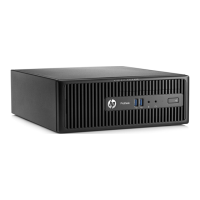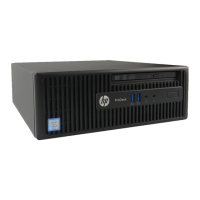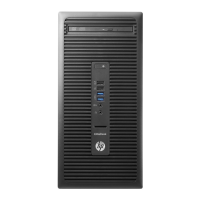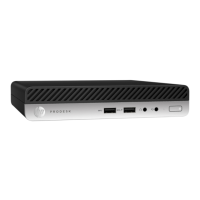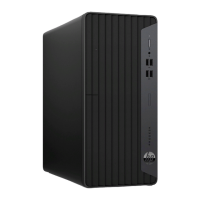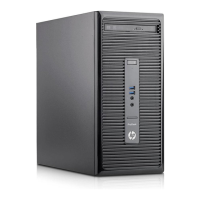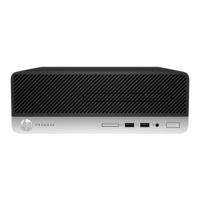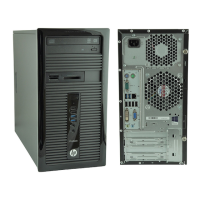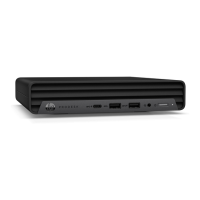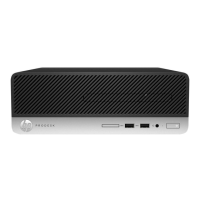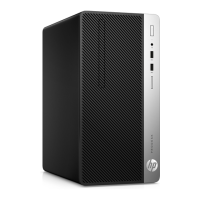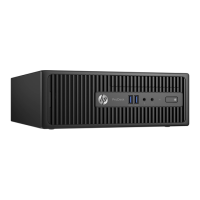
Do you have a question about the HP ProDesk 400 G3 Small Form Factor and is the answer not in the manual?
| Operating System | Windows 10 Pro |
|---|---|
| Form Factor | Small Form Factor |
| Processor | Intel Core i3/i5/i7 |
| RAM | Up to 32 GB DDR4 |
| Storage | 256 GB SSD |
| Graphics | Intel HD Graphics 530 |
| Ports | USB 3.0, USB 2.0, DisplayPort, VGA, HDMI, audio in/out |
| Networking | Gigabit Ethernet, optional Wi-Fi |
| Dimensions | 13.3 x 3.9 x 12.1 inches |
| Power Supply | 180W |
Describes general features and orientation options for the computer model.
Explains where to find the serial and product ID numbers for service assistance.
Identifies and describes connectors and buttons on the front of the computer.
Identifies and describes connectors on the rear of the computer.
Illustrates and lists key internal components like system board and power supply.
Lists various internal and external cables and adapters for computer connectivity.
Lists miscellaneous computer parts including fans, speakers, and connectors.
Lists different types of hard drives and optical drives available for the computer.
Explains ESD risks, static generation, prevention methods, grounding, and materials.
Covers operating guidelines, routine care, cleaning components, service considerations, and tools.
Details SATA drive characteristics, cables, SMART ATA drives, and cable management practices.
Steps for preparation, removing access panel, front bezel, and optical drive bezel blank.
Procedures for expansion cards, drive cages, memory modules, system board connections, and drives.
Instructions for replacing fans, fan sinks, processors, power supplies, I/O, and speakers.
Steps for system board removal/installation, callouts, and changing orientation.
Overview of what can be done with the Computer Setup utility.
Steps to access and navigate the Computer Setup utility interface.
Details of the 'Main' section, including system information and diagnostics.
Details security settings like BIOS passwords, TPM, and boot block verification.
Details advanced configuration settings for boot options, power management, and devices.
Guidelines for establishing a safe and comfortable work environment.
Steps to take before contacting technical support for problem isolation.
General suggestions and checks for troubleshooting common computer issues.
Common computer problems and their recommended solutions.
Troubleshooting steps for hard drive errors, including bad sectors and disk transactions.
Troubleshooting steps for issues with digital camera media card readers.
Troubleshooting steps for blank screens, dim characters, and blurry video.
Troubleshooting steps for sound issues, including no sound or intermittent audio.
Troubleshooting steps for printer issues like not printing or garbled output.
Troubleshooting steps for keyboard and mouse malfunctions and connectivity issues.
Troubleshooting steps for issues with newly installed hardware devices.
Troubleshooting steps for issues with USB devices, headphones, or microphones.
Troubleshooting steps for connectivity issues to the internet or web browsers.
Troubleshooting steps for software issues like installation errors or crashes.
Lists POST errors with numeric codes, text messages, and recommended actions.
Explains how to interpret diagnostic front panel LEDs and audible code patterns.
Steps to reset administrator and power-on passwords using the password jumper.
Instructions for clearing and resetting BIOS settings to factory defaults.
Overview of the HP PC Hardware Diagnostics tool for hardware testing.
Steps to download the diagnostic tool to a USB drive for bootable execution.
Overview of backup, recovery, and reset tools for Windows 8 and 8.1 systems.
Overview of backup, recovery, system restore, and media creation for Windows 7.
Detailed steps for system recovery using recovery images, media, or OS media.
Instructions for safely removing and installing the computer's internal battery.
Details about volatile and non-volatile memory types in the system.
General and country-specific requirements for power cord sets.
Technical specifications for chassis, temperature, humidity, power supply, and altitude.
